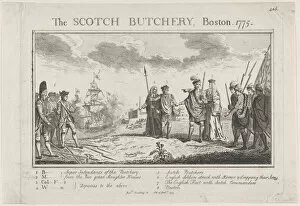Earl Of Mansfield Collection
The Earl of Mansfield, also known as William Murray, was a prominent figure in 18th century British history
All Professionally Made to Order for Quick Shipping
The Earl of Mansfield, also known as William Murray, was a prominent figure in 18th century British history. Born in Scotland, he rose to become one of the most influential judges and politicians of his time. His legacy is captured through various artworks and historical events. One such event took place at The Scotch Butchery in Boston in 1775. It was during this time that tensions were rising between Britain and its American colonies. The anonymous creator of this scene depicted the bustling activity within the butchery, perhaps symbolizing the political turmoil surrounding Mansfield's era. Another artwork that showcases Mansfield's influence is the Punch Bowl from around 1769. Created by an unknown artist, it portrays a lively gathering where people enjoy their drinks while engaging in conversation and laughter. This image reflects the social circles that Mansfield would have been a part of as an esteemed member of society. Mansfield's portrait can be seen in different forms throughout history. An engraving titled "Murray, Earl of Mansfield" captures his dignified presence with intricate details highlighting his status and authority. Additionally, an enamel on copper piece called "Portrait of Sir William Murray" offers a more intimate portrayal, showcasing his features with delicate brushstrokes. Not only was Lord Mansfield involved in legal matters and politics but he also enjoyed recreational activities like curling matches on Airthrie Loch against other nobles such as the Earl of Eglington. Engravings depicting these sporting events give us insight into his leisurely pursuits outside courtrooms and parliamentary debates. Scone Palace located in Perthshire, Scotland served as home to Lord Mansfield for many years; its grandeur reflecting his elevated position within society. Similarly, Kenwood House situated in Hampstead showcased his refined taste for architecture during late 18th century London. Numerous portraits created by talented artists over time immortalize Lord Mansfield’s likeness including those painted by Farberger, Henry Thomas Ryall, J Chapman, and W Holl.












